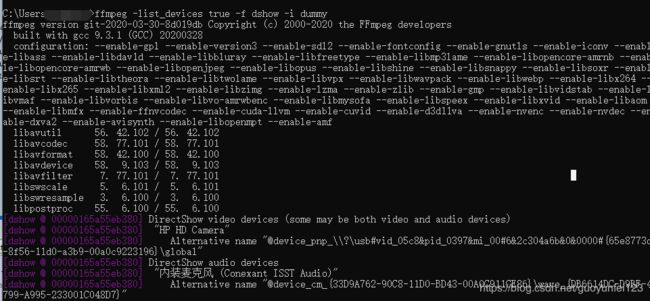FFmpeg —— 6.示例程序(一):FFmpeg+SDL2.0 打开Windows摄像头
关于FFmpeg的相关教程,大家可以去参考雷霄骅的相关博文,写的很详细。
程序源码
/**
* 最简单的基于FFmpeg的AVDevice例子(读取摄像头)
*
* 本程序实现了本地摄像头数据的获取解码和显示。是基于FFmpeg
* 的libavdevice类库最简单的例子。通过该例子,可以学习FFmpeg中
* libavdevice类库的使用方法。
* 本程序在Windows下可以使用2种方式读取摄像头数据:
* 1.VFW: Video for Windows 屏幕捕捉设备。注意输入URL是设备的序号,
* 从0至9。
* 2.dshow: 使用Directshow。注意作者机器上的摄像头设备名称是
* “Integrated Camera”,使用的时候需要改成自己电脑上摄像头设
* 备的名称。
* 在Linux下可以使用video4linux2读取摄像头设备。
* 在MacOS下可以使用avfoundation读取摄像头设备。
*
*/
#include
#define __STDC_CONSTANT_MACROS
extern "C"
{
#include "libavcodec/avcodec.h"
#include "libavformat/avformat.h"
#include "libswscale/swscale.h"
#include "libavdevice/avdevice.h"
#include "libavutil/imgutils.h"
#include "libavutil/dict.h"
#include "SDL2/SDL.h"
};
#define USE_DSHOW 0
//Refresh Event
#define SFM_REFRESH_EVENT (SDL_USEREVENT + 1)
#define SFM_BREAK_EVENT (SDL_USEREVENT + 2)
int thread_exit = 0;
int sfp_refresh_thread(void *opaque)
{
thread_exit = 0;
while (!thread_exit)
{
SDL_Event event;
event.type = SFM_REFRESH_EVENT;
SDL_PushEvent(&event);
SDL_Delay(40);
}
thread_exit = 0;
SDL_Event event;
event.type = SFM_BREAK_EVENT;
SDL_PushEvent(&event);
return 0;
}
//Show Dshow Device
void show_dshow_device()
{
AVFormatContext *pFormatCtx = avformat_alloc_context();
AVDictionary* options = NULL; av_dict_set(&options,"list_devices","true",0);
AVInputFormat *iformat = av_find_input_format("dshow");
printf("========Device Info=============\n");
avformat_open_input(&pFormatCtx,"video=dummy",iformat,&options);
printf("================================\n");
avformat_free_context(pFormatCtx);
}
//Show Dshow Device Option
void show_dshow_device_option()
{
AVFormatContext *pFormatCtx = avformat_alloc_context();
AVDictionary* options = NULL;
av_dict_set(&options,"list_options","true",0);
AVInputFormat *iformat = av_find_input_format("dshow");
printf("========Device Option Info======\n");
avformat_open_input(&pFormatCtx,"video=HP HD Camera",iformat,&options);
printf("================================\n");
avformat_free_context(pFormatCtx);
}
//Show VFW Device
void show_vfw_device()
{
AVFormatContext *pFormatCtx = avformat_alloc_context();
AVInputFormat *iformat = av_find_input_format("vfwcap");
printf("========VFW Device Info======\n");
avformat_open_input(&pFormatCtx,"list",iformat,NULL);
printf("=============================\n");
avformat_free_context(pFormatCtx);
}
int main(int argc, char *argv[])
{
AVFormatContext *pFormatCtx;
AVStream *stream;
AVCodecContext *pCodecCtx;
AVCodec *pCodec;
AVFrame *pFrame, *pFrameYUV;
AVPacket *pPacket;
SwsContext *pImgConvertCtx;
int videoIndex = -1;
unsigned int i = 0;
unsigned char *outBuffer;
SDL_Window *screen;
SDL_Renderer *sdlRenderer;
SDL_Texture *sdlTextture;
SDL_Rect sdlRect;
int screen_w = 0;
int screen_h = 0;
int ret;
// int gotPicture;
printf("Starting...\n");
//register device
avdevice_register_all();
pFormatCtx = avformat_alloc_context();
show_dshow_device();
show_dshow_device_option();
show_vfw_device();
#if USE_DSHOW
AVInputFormat *ifmt = av_find_input_format("dshow");
//set own video device's name
if (avformat_open_input(&pFormatCtx, "video=HP HD Camera", ifmt, NULL))
{
printf("can't open input stream.\n");
return -1;
}
#else
AVInputFormat *ifmt = av_find_input_format("vfwcap");
AVDictionary *paramDict = NULL;
// av_dict_set_int(¶mDict, "rtbufsize", 1024*1024*30, 0);
if (avformat_open_input(&pFormatCtx, "0", ifmt, ¶mDict) != 0)
{
printf("can't open input stream.\n");
return -1;
}
#endif
if (avformat_find_stream_info(pFormatCtx, NULL) < 0)
{
printf("can't find stream information.\n");
return -1;
}
for (i=0; inb_streams; i++)
{
if(pFormatCtx->streams[i]->codecpar->codec_type == AVMEDIA_TYPE_VIDEO)
{
videoIndex = i;
break;
}
}
if (videoIndex == -1)
{
printf("can't find a video stream.\n");
return -1;
}
stream = pFormatCtx->streams[videoIndex];
pCodec = avcodec_find_decoder(stream->codecpar->codec_id);
if (pCodec == NULL)
{
printf("codec not found.\n");
return -1;
}
pCodecCtx = avcodec_alloc_context3(pCodec);
if (!pCodecCtx)
{
printf("can't alloc codec context.\n");
return -1;
}
avcodec_parameters_to_context(pCodecCtx, stream->codecpar);
if (avcodec_open2(pCodecCtx, pCodec, NULL) < 0)
{
printf("can't open codec.\n");
return -1;
}
pFrame = av_frame_alloc();
pFrameYUV = av_frame_alloc();
outBuffer = (unsigned char *)av_malloc(av_image_get_buffer_size(AV_PIX_FMT_YUV420P, pCodecCtx->width, pCodecCtx->height,1));
av_image_fill_arrays(pFrameYUV->data, pFrameYUV->linesize, outBuffer,
AV_PIX_FMT_YUV420P, pCodecCtx->width, pCodecCtx->height, 1);
pPacket = (AVPacket *)av_malloc(sizeof(AVPacket));
printf("--------------- File Information ----------------\n");
av_dump_format(pFormatCtx, 0, 0, 0);
printf("-------------------------------------------------\n");
pImgConvertCtx = sws_getContext(pCodecCtx->width, pCodecCtx->height, pCodecCtx->pix_fmt,
pCodecCtx->width, pCodecCtx->height, AV_PIX_FMT_YUV420P, SWS_BICUBIC, NULL, NULL, NULL);
//SDL handle
if (SDL_Init(SDL_INIT_VIDEO | SDL_INIT_AUDIO | SDL_INIT_TIMER))
{
printf("can't initialize SDL - %s\n", SDL_GetError());
return -1;
}
screen_w = pCodecCtx->width;
screen_h = pCodecCtx->height;
//SDL 2.0 support for multiple windows
screen = SDL_CreateWindow("Simplest ffmpeg device(read camera)", SDL_WINDOWPOS_UNDEFINED, SDL_WINDOWPOS_UNDEFINED,
screen_w, screen_h,
SDL_WINDOW_OPENGL);
if (!screen)
{
printf("SDL: can't create window - exiting: %s\n", SDL_GetError());
return -1;
}
sdlRenderer = SDL_CreateRenderer(screen, -1, 0);
//IYUV: Y + U + V (3 planes)
//YV12: Y + V + U (3 planes)
sdlTextture = SDL_CreateTexture(sdlRenderer, SDL_PIXELFORMAT_IYUV, SDL_TEXTUREACCESS_STREAMING, pCodecCtx->width, pCodecCtx->height);
sdlRect.x = 0;
sdlRect.y = 0;
sdlRect.w = screen_w;
sdlRect.h = screen_h;
while (av_read_frame(pFormatCtx, pPacket) >= 0)
{
if (pPacket->stream_index == videoIndex)
{
ret = avcodec_send_packet(pCodecCtx, pPacket);
if (ret < 0)
{
printf("Decode error.\n");
return -1;
}
if (avcodec_receive_frame(pCodecCtx, pFrame) >= 0)
{
sws_scale(pImgConvertCtx, (const unsigned char* const*)pFrame->data, pFrame->linesize, 0, pCodecCtx->height,
pFrameYUV->data, pFrameYUV->linesize);
#if OUTPUT_YUV420P
y_size=pCodecCtx->width*pCodecCtx->height;
fwrite(pFrameYUV->data[0],1,y_size,fp_yuv); //Y
fwrite(pFrameYUV->data[1],1,y_size/4,fp_yuv); //U
fwrite(pFrameYUV->data[2],1,y_size/4,fp_yuv); //V
#endif
SDL_UpdateTexture(sdlTextture, &sdlRect, pFrameYUV->data[0], pFrameYUV->linesize[0]);
SDL_RenderClear(sdlRenderer);
SDL_RenderCopy(sdlRenderer, sdlTextture, NULL, &sdlRect);
SDL_RenderPresent(sdlRenderer);
//SDL end, delay 40ms
SDL_Delay(40);
}
}
av_packet_unref(pPacket);
}
sws_freeContext(pImgConvertCtx);
SDL_Quit();
av_free(outBuffer);
av_frame_free(&pFrameYUV);
av_frame_free(&pFrame);
avcodec_close(pCodecCtx);
avformat_close_input(&pFormatCtx);
return 0;
}
代码分析
FFmpeg中有一个和多媒体设备交互的类库:Libavdevice。使用这个库可以读取电脑(或者其他设备上)的多媒体设备的数据,或者输出数据到指定的多媒体设备上。
使用libavdevice读取数据和直接打开视频文件比较类似。因为系统的设备也被FFmpeg认为是一种输入的格式(即AVInputFormat)。使用FFmpeg打开一个普通的视频文件使用如下函数:
AVFormatContext *pFormatCtx = avformat_alloc_context();
avformat_open_input(&pFormatCtx, "test.h265",NULL,NULL);使用libavdevice的时候,唯一的不同在于需要首先查找用于输入的设备。在这里使用av_find_input_format()完成:
AVFormatContext *pFormatCtx = avformat_alloc_context();
AVInputFormat *ifmt=av_find_input_format("vfwcap");
avformat_open_input(&pFormatCtx, 0, ifmt,NULL); 上述代码首先指定了vfw设备作为输入设备,然后在URL中指定打开第0个设备(在我自己计算机上即是摄像头设备)。
在Windows平台上除了使用vfw设备作为输入设备之外,还可以使用DirectShow作为输入设备:
AVFormatContext *pFormatCtx = avformat_alloc_context();
AVInputFormat *ifmt=av_find_input_format("dshow");
avformat_open_input(&pFormatCtx,"video=HP HD Camera",ifmt,NULL) ;注意事项
1. URL的格式是"video={设备名称}",但是设备名称外面不能加引号。例如在上述例子中URL是"video=Integrated Camera",而不能写成"video=\"Integrated Camera\"",否则就无法打开设备。这与直接使用ffmpeg.exe打开dshow设备(命令为:ffmpeg -list_options true -f dshow -i video="Integrated Camera")有很大的不同。
2. Dshow的设备名称必须要提前获取,在这里有两种方法:
(1) 通过FFmpeg编程实现。使用如下代码:
//Show Device
void show_dshow_device(){
AVFormatContext *pFormatCtx = avformat_alloc_context();
AVDictionary* options = NULL;
av_dict_set(&options,"list_devices","true",0);
AVInputFormat *iformat = av_find_input_format("dshow");
printf("Device Info=============\n");
avformat_open_input(&pFormatCtx,"video=dummy",iformat,&options);
printf("========================\n");
}上述代码实际上相当于输入了下面一条命令:
ffmpeg -list_devices true -f dshow -i dummy
该方法好处是可以使用程序自动获取名称。但是当设备名称中包含中文字符的时候,会出现设备名称为乱码的情况。如果直接把乱码的设备名作为输入的话,是无法打开该设备的。这时候需要把乱码ANSI转换为UTF-8。例如上图中的第一个音频设备显示为“鍐呰楹﹀厠椋?(Conexant 20672 SmartAudi”,转码之后即为“内装麦克风 (Conexant 20672 SmartAudi”。使用转码之后的名称即可打开该设备。
参考
https://blog.csdn.net/leixiaohua1020/article/details/39702113
https://blog.csdn.net/cairo123/article/details/78780407
